Birkbeck Econometrics Project: Exchange Rate Exposure of Firms
VerifiedAdded on 2022/08/16
|20
|4969
|11
Project
AI Summary
This project investigates the impact of exchange rate exposure on the financial performance of firms. The study utilizes an econometric model, supported by Eviews analysis, to evaluate the relationship between exchange rate fluctuations and firm performance. The paper begins with an executive summary, followed by an introduction that defines exchange rate exposure and its significance in international markets. It then presents a background of the study, outlining the aims, objectives, and research questions. A comprehensive literature review explores the types of exchange exposures, including translation, economic, and transaction risks. The methodology section details the research philosophy, approach, design, data collection techniques, and data analysis plan. The study focuses on the relationship between exchange rate exposure and the financial structure of firms, analyzing the dependent and independent variables, and assessing the impact of currency exposure. The data analysis includes the study of excess returns in markets and exchange rate returns, with the aim of establishing the effects of exchange rate returns on the financial performance of firms. The project uses data from three well-known British firms to estimate the relationship between exchange exposure and the growth of firms. The conclusion summarizes the key findings and their implications. The study is a detailed analysis of the effects of exchange rate exposure on the financial performance of firms.
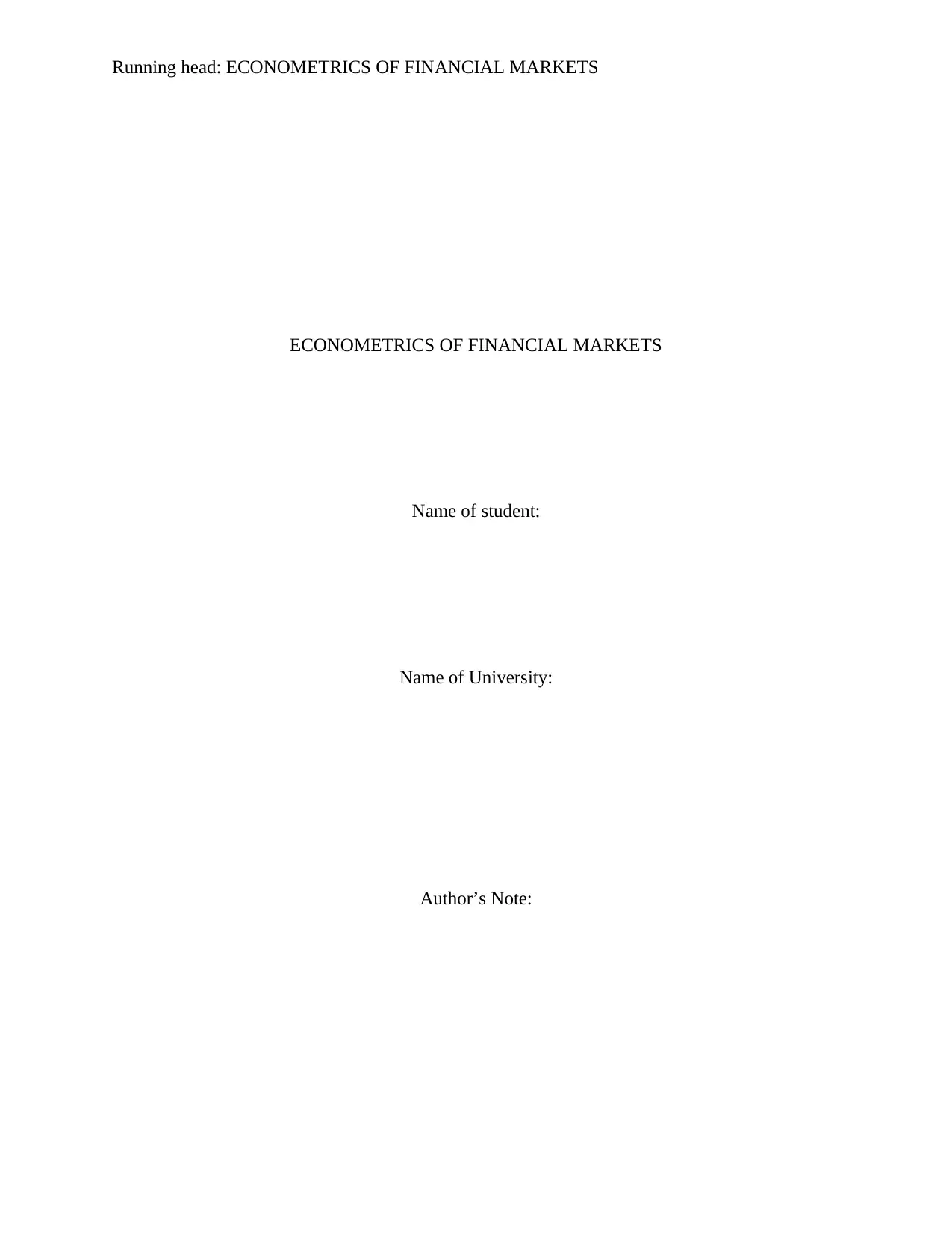
Running head: ECONOMETRICS OF FINANCIAL MARKETS
ECONOMETRICS OF FINANCIAL MARKETS
Name of student:
Name of University:
Author’s Note:
ECONOMETRICS OF FINANCIAL MARKETS
Name of student:
Name of University:
Author’s Note:
Paraphrase This Document
Need a fresh take? Get an instant paraphrase of this document with our AI Paraphraser
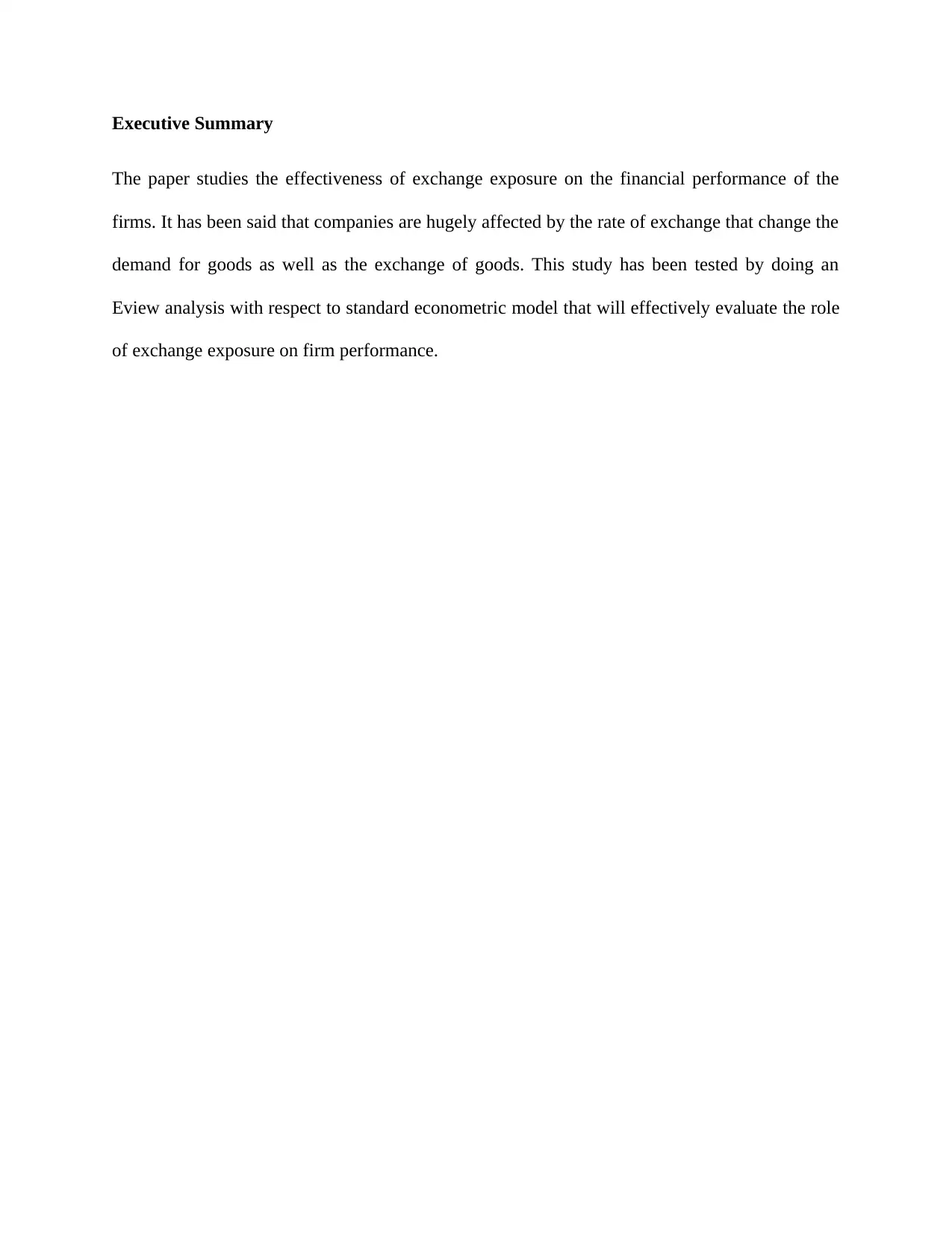
Executive Summary
The paper studies the effectiveness of exchange exposure on the financial performance of the
firms. It has been said that companies are hugely affected by the rate of exchange that change the
demand for goods as well as the exchange of goods. This study has been tested by doing an
Eview analysis with respect to standard econometric model that will effectively evaluate the role
of exchange exposure on firm performance.
The paper studies the effectiveness of exchange exposure on the financial performance of the
firms. It has been said that companies are hugely affected by the rate of exchange that change the
demand for goods as well as the exchange of goods. This study has been tested by doing an
Eview analysis with respect to standard econometric model that will effectively evaluate the role
of exchange exposure on firm performance.
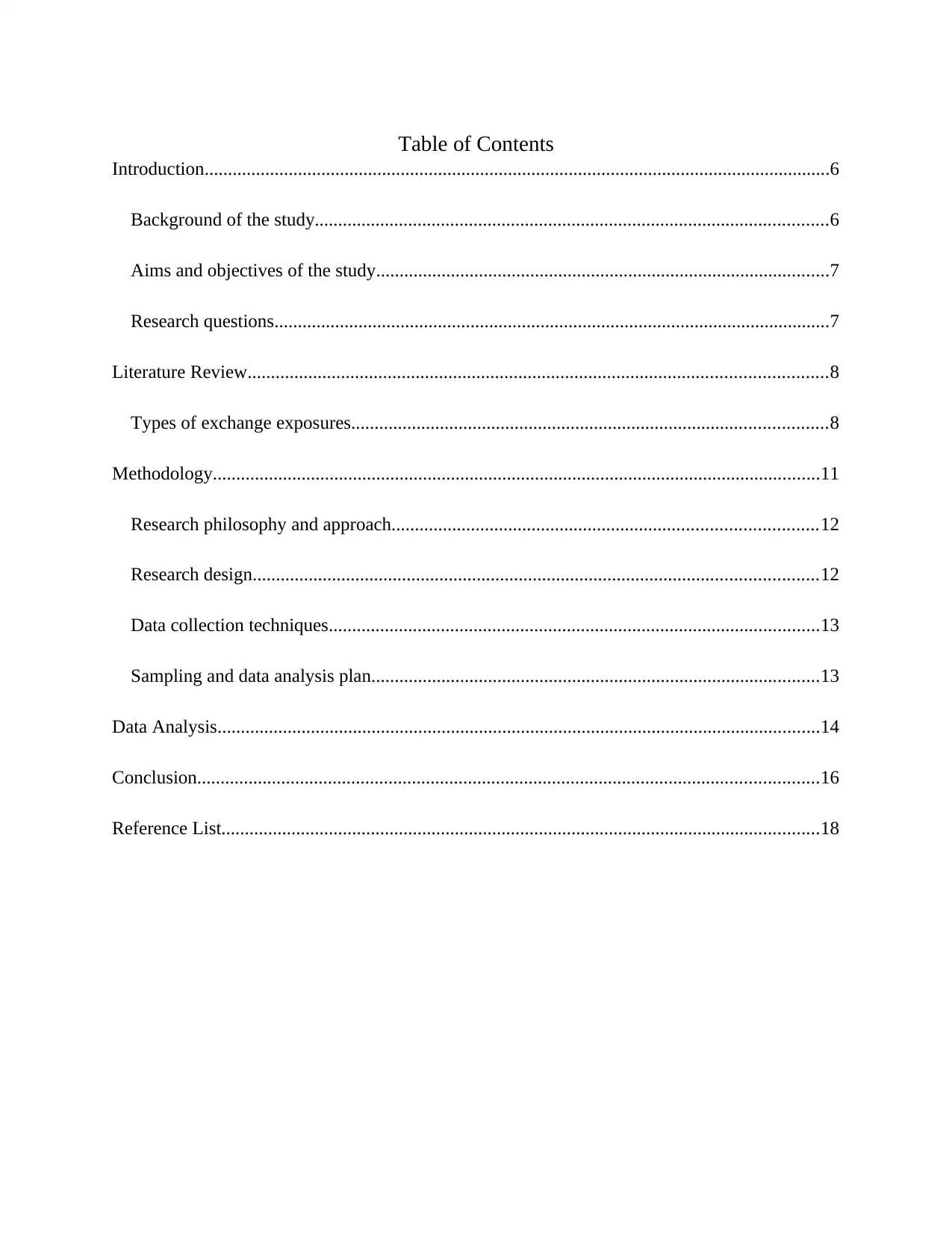
Table of Contents
Introduction......................................................................................................................................6
Background of the study..............................................................................................................6
Aims and objectives of the study.................................................................................................7
Research questions.......................................................................................................................7
Literature Review............................................................................................................................8
Types of exchange exposures......................................................................................................8
Methodology..................................................................................................................................11
Research philosophy and approach...........................................................................................12
Research design.........................................................................................................................12
Data collection techniques.........................................................................................................13
Sampling and data analysis plan................................................................................................13
Data Analysis.................................................................................................................................14
Conclusion.....................................................................................................................................16
Reference List................................................................................................................................18
Introduction......................................................................................................................................6
Background of the study..............................................................................................................6
Aims and objectives of the study.................................................................................................7
Research questions.......................................................................................................................7
Literature Review............................................................................................................................8
Types of exchange exposures......................................................................................................8
Methodology..................................................................................................................................11
Research philosophy and approach...........................................................................................12
Research design.........................................................................................................................12
Data collection techniques.........................................................................................................13
Sampling and data analysis plan................................................................................................13
Data Analysis.................................................................................................................................14
Conclusion.....................................................................................................................................16
Reference List................................................................................................................................18
⊘ This is a preview!⊘
Do you want full access?
Subscribe today to unlock all pages.

Trusted by 1+ million students worldwide

Paraphrase This Document
Need a fresh take? Get an instant paraphrase of this document with our AI Paraphraser
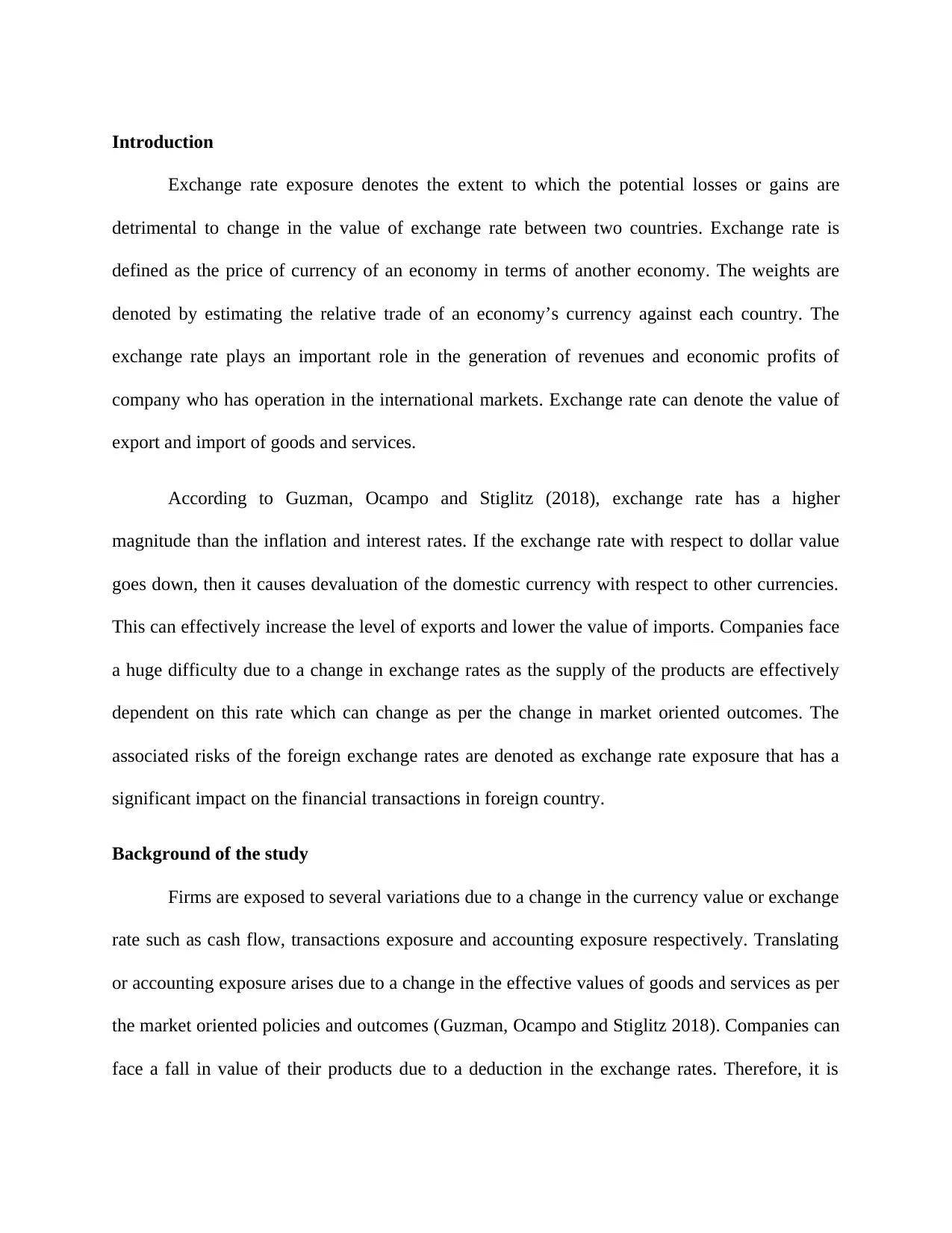
Introduction
Exchange rate exposure denotes the extent to which the potential losses or gains are
detrimental to change in the value of exchange rate between two countries. Exchange rate is
defined as the price of currency of an economy in terms of another economy. The weights are
denoted by estimating the relative trade of an economy’s currency against each country. The
exchange rate plays an important role in the generation of revenues and economic profits of
company who has operation in the international markets. Exchange rate can denote the value of
export and import of goods and services.
According to Guzman, Ocampo and Stiglitz (2018), exchange rate has a higher
magnitude than the inflation and interest rates. If the exchange rate with respect to dollar value
goes down, then it causes devaluation of the domestic currency with respect to other currencies.
This can effectively increase the level of exports and lower the value of imports. Companies face
a huge difficulty due to a change in exchange rates as the supply of the products are effectively
dependent on this rate which can change as per the change in market oriented outcomes. The
associated risks of the foreign exchange rates are denoted as exchange rate exposure that has a
significant impact on the financial transactions in foreign country.
Background of the study
Firms are exposed to several variations due to a change in the currency value or exchange
rate such as cash flow, transactions exposure and accounting exposure respectively. Translating
or accounting exposure arises due to a change in the effective values of goods and services as per
the market oriented policies and outcomes (Guzman, Ocampo and Stiglitz 2018). Companies can
face a fall in value of their products due to a deduction in the exchange rates. Therefore, it is
Exchange rate exposure denotes the extent to which the potential losses or gains are
detrimental to change in the value of exchange rate between two countries. Exchange rate is
defined as the price of currency of an economy in terms of another economy. The weights are
denoted by estimating the relative trade of an economy’s currency against each country. The
exchange rate plays an important role in the generation of revenues and economic profits of
company who has operation in the international markets. Exchange rate can denote the value of
export and import of goods and services.
According to Guzman, Ocampo and Stiglitz (2018), exchange rate has a higher
magnitude than the inflation and interest rates. If the exchange rate with respect to dollar value
goes down, then it causes devaluation of the domestic currency with respect to other currencies.
This can effectively increase the level of exports and lower the value of imports. Companies face
a huge difficulty due to a change in exchange rates as the supply of the products are effectively
dependent on this rate which can change as per the change in market oriented outcomes. The
associated risks of the foreign exchange rates are denoted as exchange rate exposure that has a
significant impact on the financial transactions in foreign country.
Background of the study
Firms are exposed to several variations due to a change in the currency value or exchange
rate such as cash flow, transactions exposure and accounting exposure respectively. Translating
or accounting exposure arises due to a change in the effective values of goods and services as per
the market oriented policies and outcomes (Guzman, Ocampo and Stiglitz 2018). Companies can
face a fall in value of their products due to a deduction in the exchange rates. Therefore, it is
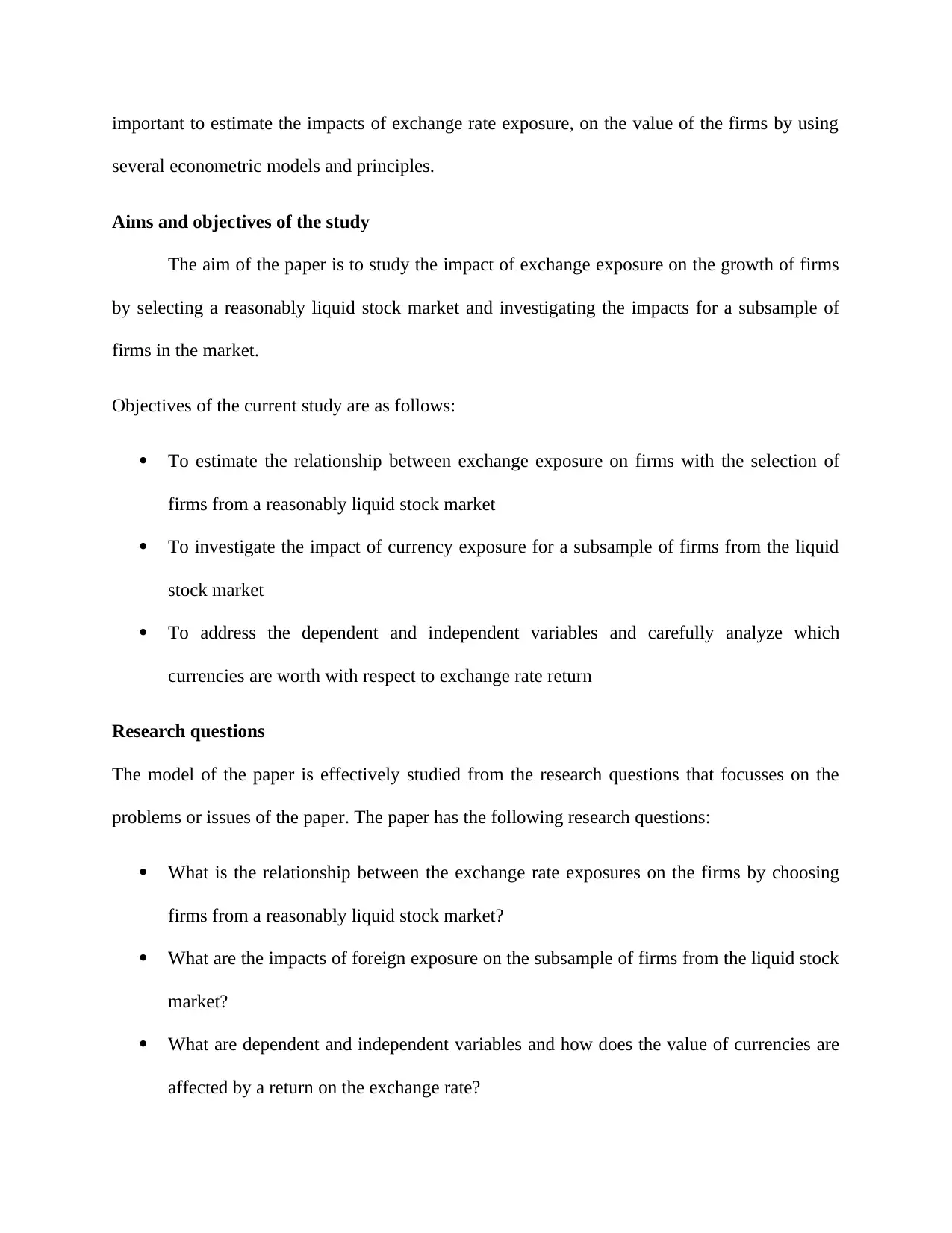
important to estimate the impacts of exchange rate exposure, on the value of the firms by using
several econometric models and principles.
Aims and objectives of the study
The aim of the paper is to study the impact of exchange exposure on the growth of firms
by selecting a reasonably liquid stock market and investigating the impacts for a subsample of
firms in the market.
Objectives of the current study are as follows:
To estimate the relationship between exchange exposure on firms with the selection of
firms from a reasonably liquid stock market
To investigate the impact of currency exposure for a subsample of firms from the liquid
stock market
To address the dependent and independent variables and carefully analyze which
currencies are worth with respect to exchange rate return
Research questions
The model of the paper is effectively studied from the research questions that focusses on the
problems or issues of the paper. The paper has the following research questions:
What is the relationship between the exchange rate exposures on the firms by choosing
firms from a reasonably liquid stock market?
What are the impacts of foreign exposure on the subsample of firms from the liquid stock
market?
What are dependent and independent variables and how does the value of currencies are
affected by a return on the exchange rate?
several econometric models and principles.
Aims and objectives of the study
The aim of the paper is to study the impact of exchange exposure on the growth of firms
by selecting a reasonably liquid stock market and investigating the impacts for a subsample of
firms in the market.
Objectives of the current study are as follows:
To estimate the relationship between exchange exposure on firms with the selection of
firms from a reasonably liquid stock market
To investigate the impact of currency exposure for a subsample of firms from the liquid
stock market
To address the dependent and independent variables and carefully analyze which
currencies are worth with respect to exchange rate return
Research questions
The model of the paper is effectively studied from the research questions that focusses on the
problems or issues of the paper. The paper has the following research questions:
What is the relationship between the exchange rate exposures on the firms by choosing
firms from a reasonably liquid stock market?
What are the impacts of foreign exposure on the subsample of firms from the liquid stock
market?
What are dependent and independent variables and how does the value of currencies are
affected by a return on the exchange rate?
⊘ This is a preview!⊘
Do you want full access?
Subscribe today to unlock all pages.

Trusted by 1+ million students worldwide
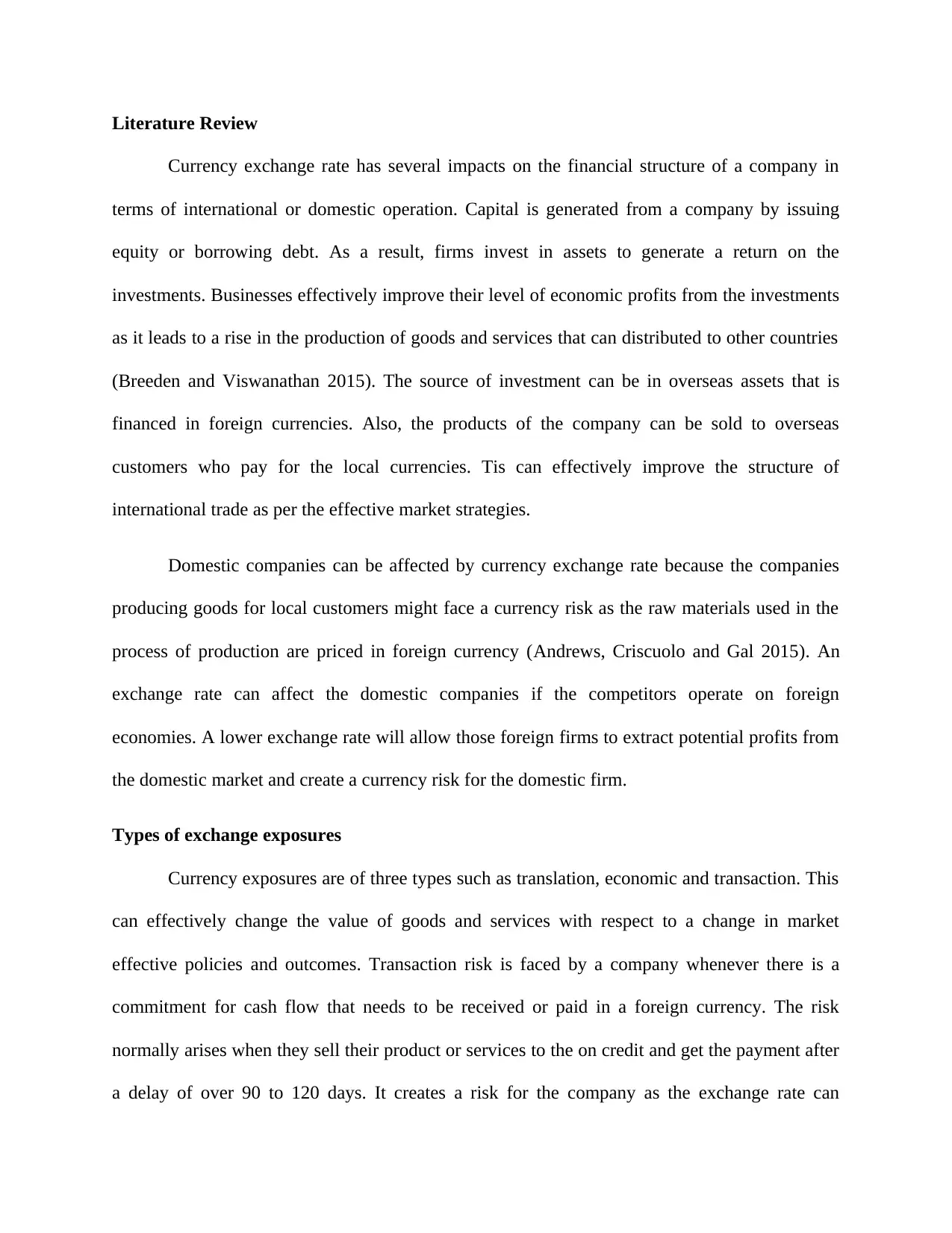
Literature Review
Currency exchange rate has several impacts on the financial structure of a company in
terms of international or domestic operation. Capital is generated from a company by issuing
equity or borrowing debt. As a result, firms invest in assets to generate a return on the
investments. Businesses effectively improve their level of economic profits from the investments
as it leads to a rise in the production of goods and services that can distributed to other countries
(Breeden and Viswanathan 2015). The source of investment can be in overseas assets that is
financed in foreign currencies. Also, the products of the company can be sold to overseas
customers who pay for the local currencies. Tis can effectively improve the structure of
international trade as per the effective market strategies.
Domestic companies can be affected by currency exchange rate because the companies
producing goods for local customers might face a currency risk as the raw materials used in the
process of production are priced in foreign currency (Andrews, Criscuolo and Gal 2015). An
exchange rate can affect the domestic companies if the competitors operate on foreign
economies. A lower exchange rate will allow those foreign firms to extract potential profits from
the domestic market and create a currency risk for the domestic firm.
Types of exchange exposures
Currency exposures are of three types such as translation, economic and transaction. This
can effectively change the value of goods and services with respect to a change in market
effective policies and outcomes. Transaction risk is faced by a company whenever there is a
commitment for cash flow that needs to be received or paid in a foreign currency. The risk
normally arises when they sell their product or services to the on credit and get the payment after
a delay of over 90 to 120 days. It creates a risk for the company as the exchange rate can
Currency exchange rate has several impacts on the financial structure of a company in
terms of international or domestic operation. Capital is generated from a company by issuing
equity or borrowing debt. As a result, firms invest in assets to generate a return on the
investments. Businesses effectively improve their level of economic profits from the investments
as it leads to a rise in the production of goods and services that can distributed to other countries
(Breeden and Viswanathan 2015). The source of investment can be in overseas assets that is
financed in foreign currencies. Also, the products of the company can be sold to overseas
customers who pay for the local currencies. Tis can effectively improve the structure of
international trade as per the effective market strategies.
Domestic companies can be affected by currency exchange rate because the companies
producing goods for local customers might face a currency risk as the raw materials used in the
process of production are priced in foreign currency (Andrews, Criscuolo and Gal 2015). An
exchange rate can affect the domestic companies if the competitors operate on foreign
economies. A lower exchange rate will allow those foreign firms to extract potential profits from
the domestic market and create a currency risk for the domestic firm.
Types of exchange exposures
Currency exposures are of three types such as translation, economic and transaction. This
can effectively change the value of goods and services with respect to a change in market
effective policies and outcomes. Transaction risk is faced by a company whenever there is a
commitment for cash flow that needs to be received or paid in a foreign currency. The risk
normally arises when they sell their product or services to the on credit and get the payment after
a delay of over 90 to 120 days. It creates a risk for the company as the exchange rate can
Paraphrase This Document
Need a fresh take? Get an instant paraphrase of this document with our AI Paraphraser
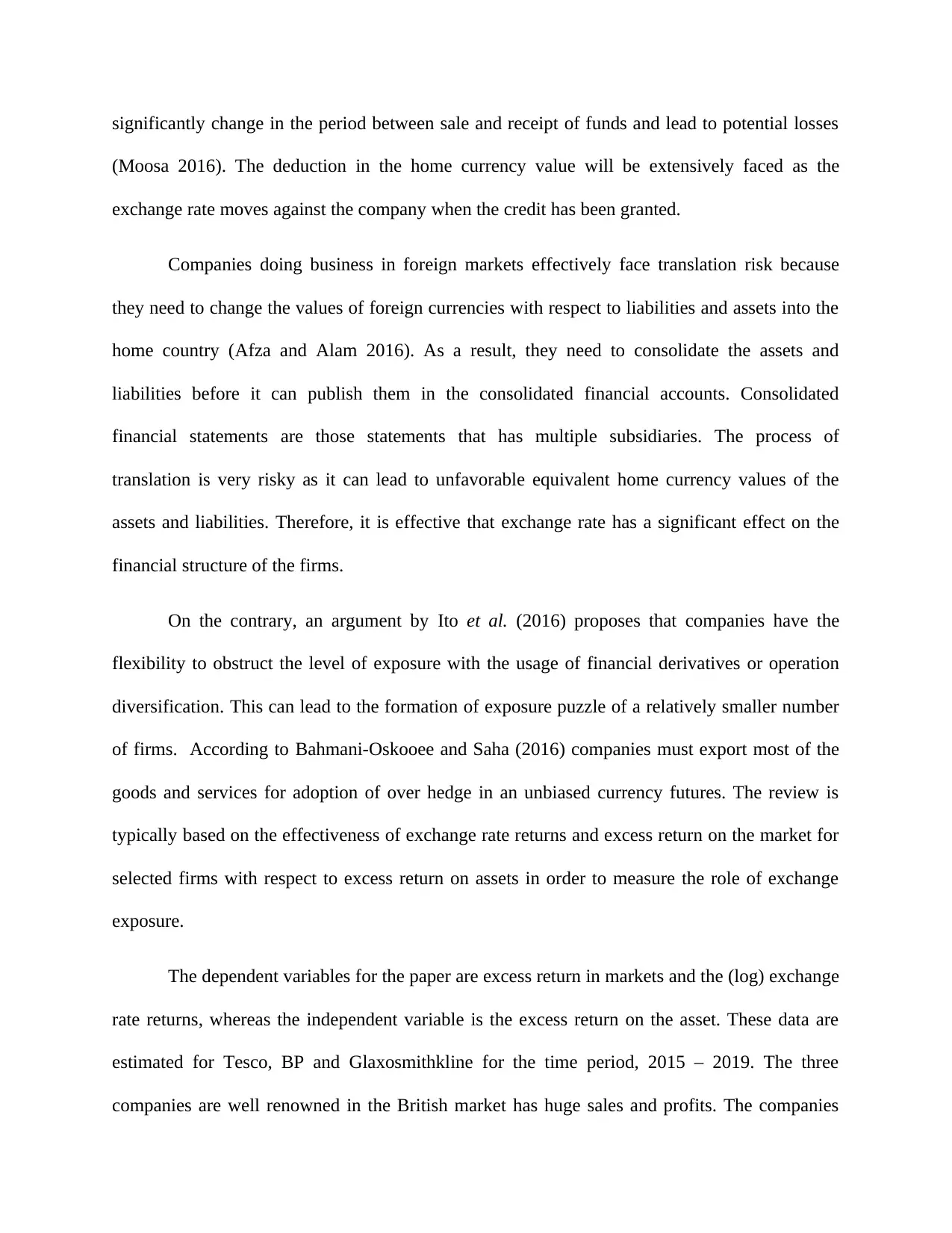
significantly change in the period between sale and receipt of funds and lead to potential losses
(Moosa 2016). The deduction in the home currency value will be extensively faced as the
exchange rate moves against the company when the credit has been granted.
Companies doing business in foreign markets effectively face translation risk because
they need to change the values of foreign currencies with respect to liabilities and assets into the
home country (Afza and Alam 2016). As a result, they need to consolidate the assets and
liabilities before it can publish them in the consolidated financial accounts. Consolidated
financial statements are those statements that has multiple subsidiaries. The process of
translation is very risky as it can lead to unfavorable equivalent home currency values of the
assets and liabilities. Therefore, it is effective that exchange rate has a significant effect on the
financial structure of the firms.
On the contrary, an argument by Ito et al. (2016) proposes that companies have the
flexibility to obstruct the level of exposure with the usage of financial derivatives or operation
diversification. This can lead to the formation of exposure puzzle of a relatively smaller number
of firms. According to Bahmani-Oskooee and Saha (2016) companies must export most of the
goods and services for adoption of over hedge in an unbiased currency futures. The review is
typically based on the effectiveness of exchange rate returns and excess return on the market for
selected firms with respect to excess return on assets in order to measure the role of exchange
exposure.
The dependent variables for the paper are excess return in markets and the (log) exchange
rate returns, whereas the independent variable is the excess return on the asset. These data are
estimated for Tesco, BP and Glaxosmithkline for the time period, 2015 – 2019. The three
companies are well renowned in the British market has huge sales and profits. The companies
(Moosa 2016). The deduction in the home currency value will be extensively faced as the
exchange rate moves against the company when the credit has been granted.
Companies doing business in foreign markets effectively face translation risk because
they need to change the values of foreign currencies with respect to liabilities and assets into the
home country (Afza and Alam 2016). As a result, they need to consolidate the assets and
liabilities before it can publish them in the consolidated financial accounts. Consolidated
financial statements are those statements that has multiple subsidiaries. The process of
translation is very risky as it can lead to unfavorable equivalent home currency values of the
assets and liabilities. Therefore, it is effective that exchange rate has a significant effect on the
financial structure of the firms.
On the contrary, an argument by Ito et al. (2016) proposes that companies have the
flexibility to obstruct the level of exposure with the usage of financial derivatives or operation
diversification. This can lead to the formation of exposure puzzle of a relatively smaller number
of firms. According to Bahmani-Oskooee and Saha (2016) companies must export most of the
goods and services for adoption of over hedge in an unbiased currency futures. The review is
typically based on the effectiveness of exchange rate returns and excess return on the market for
selected firms with respect to excess return on assets in order to measure the role of exchange
exposure.
The dependent variables for the paper are excess return in markets and the (log) exchange
rate returns, whereas the independent variable is the excess return on the asset. These data are
estimated for Tesco, BP and Glaxosmithkline for the time period, 2015 – 2019. The three
companies are well renowned in the British market has huge sales and profits. The companies
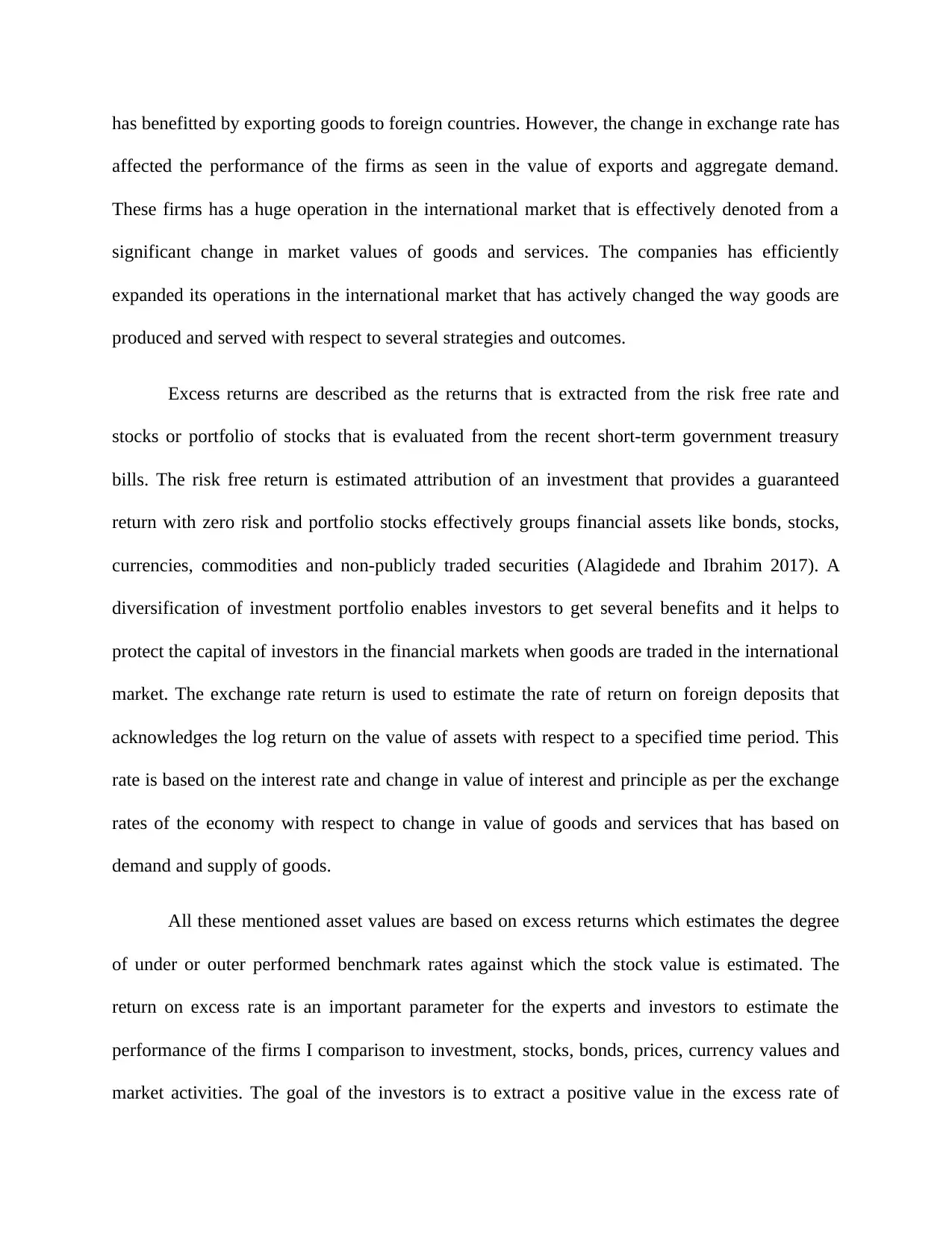
has benefitted by exporting goods to foreign countries. However, the change in exchange rate has
affected the performance of the firms as seen in the value of exports and aggregate demand.
These firms has a huge operation in the international market that is effectively denoted from a
significant change in market values of goods and services. The companies has efficiently
expanded its operations in the international market that has actively changed the way goods are
produced and served with respect to several strategies and outcomes.
Excess returns are described as the returns that is extracted from the risk free rate and
stocks or portfolio of stocks that is evaluated from the recent short-term government treasury
bills. The risk free return is estimated attribution of an investment that provides a guaranteed
return with zero risk and portfolio stocks effectively groups financial assets like bonds, stocks,
currencies, commodities and non-publicly traded securities (Alagidede and Ibrahim 2017). A
diversification of investment portfolio enables investors to get several benefits and it helps to
protect the capital of investors in the financial markets when goods are traded in the international
market. The exchange rate return is used to estimate the rate of return on foreign deposits that
acknowledges the log return on the value of assets with respect to a specified time period. This
rate is based on the interest rate and change in value of interest and principle as per the exchange
rates of the economy with respect to change in value of goods and services that has based on
demand and supply of goods.
All these mentioned asset values are based on excess returns which estimates the degree
of under or outer performed benchmark rates against which the stock value is estimated. The
return on excess rate is an important parameter for the experts and investors to estimate the
performance of the firms I comparison to investment, stocks, bonds, prices, currency values and
market activities. The goal of the investors is to extract a positive value in the excess rate of
affected the performance of the firms as seen in the value of exports and aggregate demand.
These firms has a huge operation in the international market that is effectively denoted from a
significant change in market values of goods and services. The companies has efficiently
expanded its operations in the international market that has actively changed the way goods are
produced and served with respect to several strategies and outcomes.
Excess returns are described as the returns that is extracted from the risk free rate and
stocks or portfolio of stocks that is evaluated from the recent short-term government treasury
bills. The risk free return is estimated attribution of an investment that provides a guaranteed
return with zero risk and portfolio stocks effectively groups financial assets like bonds, stocks,
currencies, commodities and non-publicly traded securities (Alagidede and Ibrahim 2017). A
diversification of investment portfolio enables investors to get several benefits and it helps to
protect the capital of investors in the financial markets when goods are traded in the international
market. The exchange rate return is used to estimate the rate of return on foreign deposits that
acknowledges the log return on the value of assets with respect to a specified time period. This
rate is based on the interest rate and change in value of interest and principle as per the exchange
rates of the economy with respect to change in value of goods and services that has based on
demand and supply of goods.
All these mentioned asset values are based on excess returns which estimates the degree
of under or outer performed benchmark rates against which the stock value is estimated. The
return on excess rate is an important parameter for the experts and investors to estimate the
performance of the firms I comparison to investment, stocks, bonds, prices, currency values and
market activities. The goal of the investors is to extract a positive value in the excess rate of
⊘ This is a preview!⊘
Do you want full access?
Subscribe today to unlock all pages.

Trusted by 1+ million students worldwide
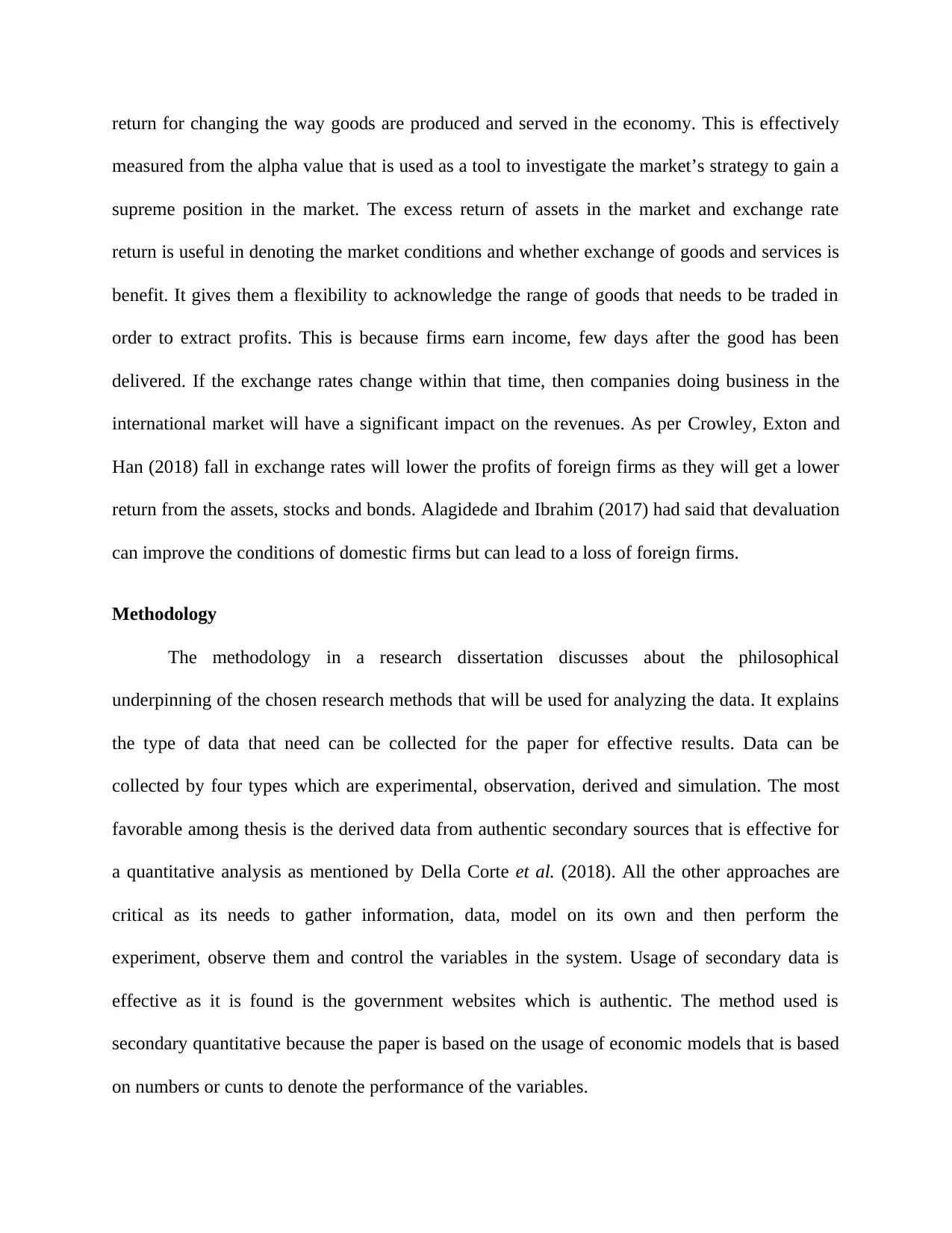
return for changing the way goods are produced and served in the economy. This is effectively
measured from the alpha value that is used as a tool to investigate the market’s strategy to gain a
supreme position in the market. The excess return of assets in the market and exchange rate
return is useful in denoting the market conditions and whether exchange of goods and services is
benefit. It gives them a flexibility to acknowledge the range of goods that needs to be traded in
order to extract profits. This is because firms earn income, few days after the good has been
delivered. If the exchange rates change within that time, then companies doing business in the
international market will have a significant impact on the revenues. As per Crowley, Exton and
Han (2018) fall in exchange rates will lower the profits of foreign firms as they will get a lower
return from the assets, stocks and bonds. Alagidede and Ibrahim (2017) had said that devaluation
can improve the conditions of domestic firms but can lead to a loss of foreign firms.
Methodology
The methodology in a research dissertation discusses about the philosophical
underpinning of the chosen research methods that will be used for analyzing the data. It explains
the type of data that need can be collected for the paper for effective results. Data can be
collected by four types which are experimental, observation, derived and simulation. The most
favorable among thesis is the derived data from authentic secondary sources that is effective for
a quantitative analysis as mentioned by Della Corte et al. (2018). All the other approaches are
critical as its needs to gather information, data, model on its own and then perform the
experiment, observe them and control the variables in the system. Usage of secondary data is
effective as it is found is the government websites which is authentic. The method used is
secondary quantitative because the paper is based on the usage of economic models that is based
on numbers or cunts to denote the performance of the variables.
measured from the alpha value that is used as a tool to investigate the market’s strategy to gain a
supreme position in the market. The excess return of assets in the market and exchange rate
return is useful in denoting the market conditions and whether exchange of goods and services is
benefit. It gives them a flexibility to acknowledge the range of goods that needs to be traded in
order to extract profits. This is because firms earn income, few days after the good has been
delivered. If the exchange rates change within that time, then companies doing business in the
international market will have a significant impact on the revenues. As per Crowley, Exton and
Han (2018) fall in exchange rates will lower the profits of foreign firms as they will get a lower
return from the assets, stocks and bonds. Alagidede and Ibrahim (2017) had said that devaluation
can improve the conditions of domestic firms but can lead to a loss of foreign firms.
Methodology
The methodology in a research dissertation discusses about the philosophical
underpinning of the chosen research methods that will be used for analyzing the data. It explains
the type of data that need can be collected for the paper for effective results. Data can be
collected by four types which are experimental, observation, derived and simulation. The most
favorable among thesis is the derived data from authentic secondary sources that is effective for
a quantitative analysis as mentioned by Della Corte et al. (2018). All the other approaches are
critical as its needs to gather information, data, model on its own and then perform the
experiment, observe them and control the variables in the system. Usage of secondary data is
effective as it is found is the government websites which is authentic. The method used is
secondary quantitative because the paper is based on the usage of economic models that is based
on numbers or cunts to denote the performance of the variables.
Paraphrase This Document
Need a fresh take? Get an instant paraphrase of this document with our AI Paraphraser
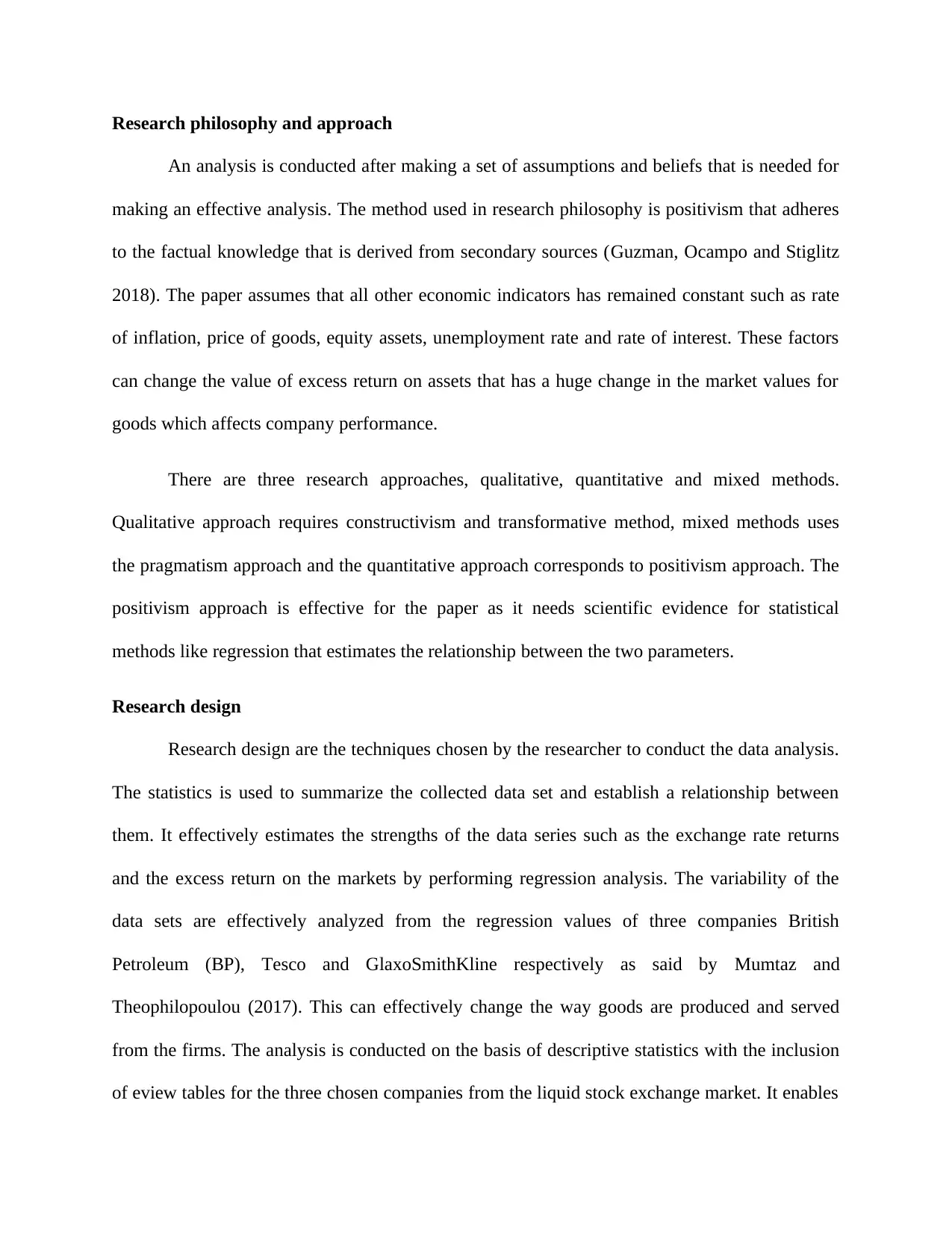
Research philosophy and approach
An analysis is conducted after making a set of assumptions and beliefs that is needed for
making an effective analysis. The method used in research philosophy is positivism that adheres
to the factual knowledge that is derived from secondary sources (Guzman, Ocampo and Stiglitz
2018). The paper assumes that all other economic indicators has remained constant such as rate
of inflation, price of goods, equity assets, unemployment rate and rate of interest. These factors
can change the value of excess return on assets that has a huge change in the market values for
goods which affects company performance.
There are three research approaches, qualitative, quantitative and mixed methods.
Qualitative approach requires constructivism and transformative method, mixed methods uses
the pragmatism approach and the quantitative approach corresponds to positivism approach. The
positivism approach is effective for the paper as it needs scientific evidence for statistical
methods like regression that estimates the relationship between the two parameters.
Research design
Research design are the techniques chosen by the researcher to conduct the data analysis.
The statistics is used to summarize the collected data set and establish a relationship between
them. It effectively estimates the strengths of the data series such as the exchange rate returns
and the excess return on the markets by performing regression analysis. The variability of the
data sets are effectively analyzed from the regression values of three companies British
Petroleum (BP), Tesco and GlaxoSmithKline respectively as said by Mumtaz and
Theophilopoulou (2017). This can effectively change the way goods are produced and served
from the firms. The analysis is conducted on the basis of descriptive statistics with the inclusion
of eview tables for the three chosen companies from the liquid stock exchange market. It enables
An analysis is conducted after making a set of assumptions and beliefs that is needed for
making an effective analysis. The method used in research philosophy is positivism that adheres
to the factual knowledge that is derived from secondary sources (Guzman, Ocampo and Stiglitz
2018). The paper assumes that all other economic indicators has remained constant such as rate
of inflation, price of goods, equity assets, unemployment rate and rate of interest. These factors
can change the value of excess return on assets that has a huge change in the market values for
goods which affects company performance.
There are three research approaches, qualitative, quantitative and mixed methods.
Qualitative approach requires constructivism and transformative method, mixed methods uses
the pragmatism approach and the quantitative approach corresponds to positivism approach. The
positivism approach is effective for the paper as it needs scientific evidence for statistical
methods like regression that estimates the relationship between the two parameters.
Research design
Research design are the techniques chosen by the researcher to conduct the data analysis.
The statistics is used to summarize the collected data set and establish a relationship between
them. It effectively estimates the strengths of the data series such as the exchange rate returns
and the excess return on the markets by performing regression analysis. The variability of the
data sets are effectively analyzed from the regression values of three companies British
Petroleum (BP), Tesco and GlaxoSmithKline respectively as said by Mumtaz and
Theophilopoulou (2017). This can effectively change the way goods are produced and served
from the firms. The analysis is conducted on the basis of descriptive statistics with the inclusion
of eview tables for the three chosen companies from the liquid stock exchange market. It enables
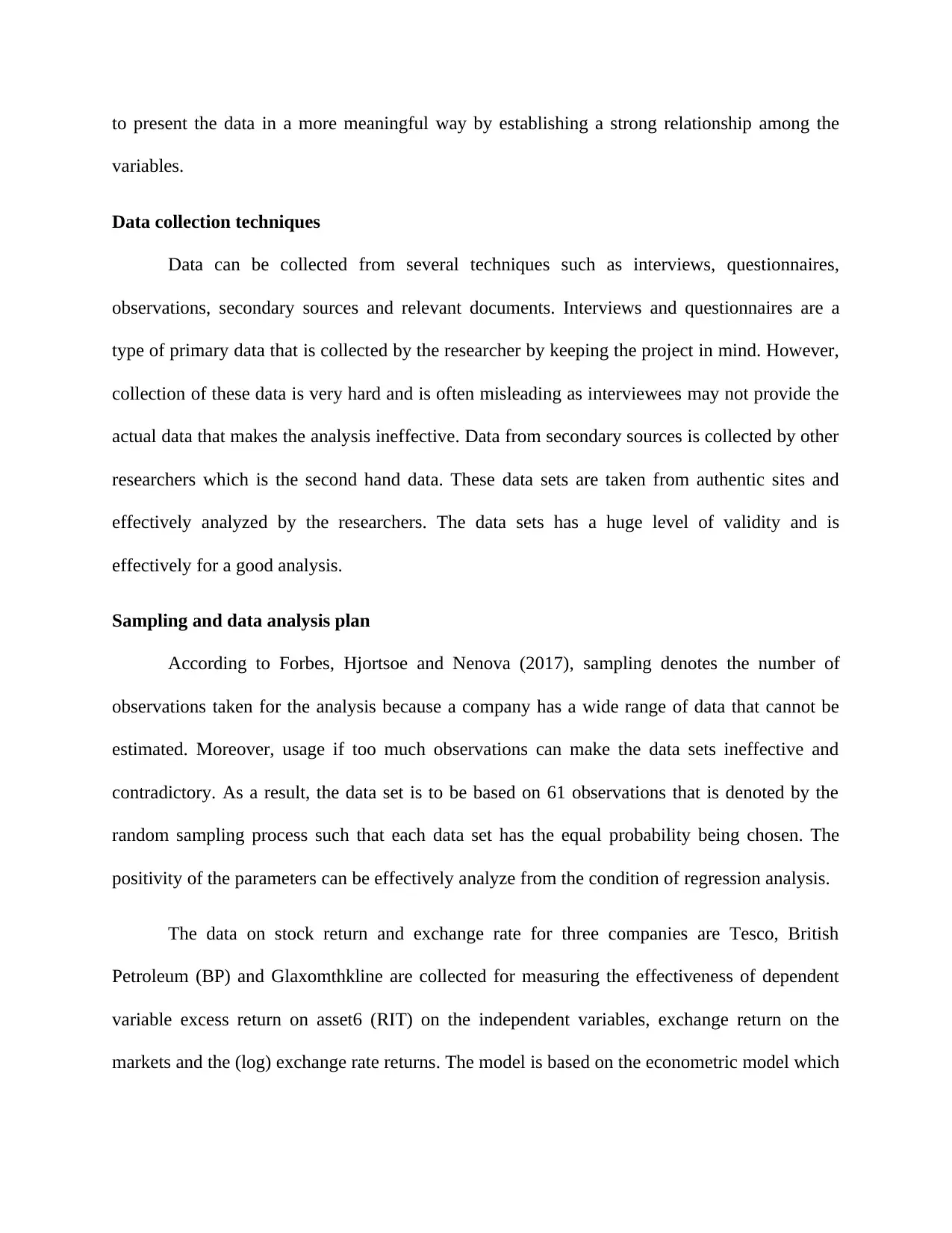
to present the data in a more meaningful way by establishing a strong relationship among the
variables.
Data collection techniques
Data can be collected from several techniques such as interviews, questionnaires,
observations, secondary sources and relevant documents. Interviews and questionnaires are a
type of primary data that is collected by the researcher by keeping the project in mind. However,
collection of these data is very hard and is often misleading as interviewees may not provide the
actual data that makes the analysis ineffective. Data from secondary sources is collected by other
researchers which is the second hand data. These data sets are taken from authentic sites and
effectively analyzed by the researchers. The data sets has a huge level of validity and is
effectively for a good analysis.
Sampling and data analysis plan
According to Forbes, Hjortsoe and Nenova (2017), sampling denotes the number of
observations taken for the analysis because a company has a wide range of data that cannot be
estimated. Moreover, usage if too much observations can make the data sets ineffective and
contradictory. As a result, the data set is to be based on 61 observations that is denoted by the
random sampling process such that each data set has the equal probability being chosen. The
positivity of the parameters can be effectively analyze from the condition of regression analysis.
The data on stock return and exchange rate for three companies are Tesco, British
Petroleum (BP) and Glaxomthkline are collected for measuring the effectiveness of dependent
variable excess return on asset6 (RIT) on the independent variables, exchange return on the
markets and the (log) exchange rate returns. The model is based on the econometric model which
variables.
Data collection techniques
Data can be collected from several techniques such as interviews, questionnaires,
observations, secondary sources and relevant documents. Interviews and questionnaires are a
type of primary data that is collected by the researcher by keeping the project in mind. However,
collection of these data is very hard and is often misleading as interviewees may not provide the
actual data that makes the analysis ineffective. Data from secondary sources is collected by other
researchers which is the second hand data. These data sets are taken from authentic sites and
effectively analyzed by the researchers. The data sets has a huge level of validity and is
effectively for a good analysis.
Sampling and data analysis plan
According to Forbes, Hjortsoe and Nenova (2017), sampling denotes the number of
observations taken for the analysis because a company has a wide range of data that cannot be
estimated. Moreover, usage if too much observations can make the data sets ineffective and
contradictory. As a result, the data set is to be based on 61 observations that is denoted by the
random sampling process such that each data set has the equal probability being chosen. The
positivity of the parameters can be effectively analyze from the condition of regression analysis.
The data on stock return and exchange rate for three companies are Tesco, British
Petroleum (BP) and Glaxomthkline are collected for measuring the effectiveness of dependent
variable excess return on asset6 (RIT) on the independent variables, exchange return on the
markets and the (log) exchange rate returns. The model is based on the econometric model which
⊘ This is a preview!⊘
Do you want full access?
Subscribe today to unlock all pages.

Trusted by 1+ million students worldwide
1 out of 20
Related Documents
Your All-in-One AI-Powered Toolkit for Academic Success.
+13062052269
info@desklib.com
Available 24*7 on WhatsApp / Email
![[object Object]](/_next/static/media/star-bottom.7253800d.svg)
Unlock your academic potential
Copyright © 2020–2025 A2Z Services. All Rights Reserved. Developed and managed by ZUCOL.




